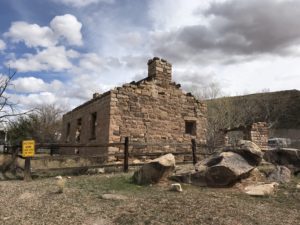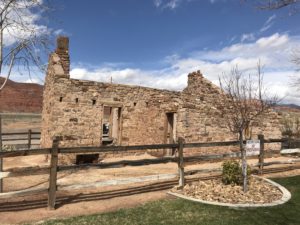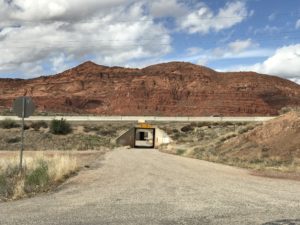Just a few miles from St. George, Utah there is the remains of yet another pioneer settlement, a little town called Harrisburg Utah.

Now a ghost town, Harrisburg Utah was established in 1859. Originally called Harrisville, it wasn’t until the town was flooded by the Virgin River in 1862 that the residents moved further up Quail Creek and changed the name to Harrisburg Utah.
But even then it wasn’t a permanent location.
Harrisburg Utah | A history
When it comes to a history speckled with hardship, Harrisburg Utah has its fair share.
The town was named after Moses Harris, a Mormon pioneer settler who moved to the town in 1859. By 1868 Harrisburg was home to 200 people.
The structures consisted largely of stone — even the fences were made of stone — because of the abundance of rocks in the area.
The town served as an agricultural support to the nearby mining town of Silver Reef for several years. Then things began to turn.
Hardship for Harrisburg Utah
In 1869 a combination of a grasshopper plague and a Navajo raid drove several of the citizens of Harrisburg Utah out. Drought became another enemy. Eventually, the majority of Harrisburg Utah residents moved to nearby Silver Reef and Leeds, leaving only six families in Harrisburg Utah in 1892. By 1895 they were all gone.
Harrisburg Utah today
Today, thousands of people drive by Harrisburg Utah without even realizing its there, thanks to its proximity to I-15. It’s one of those towns that if you blink, you might miss it. But regular passersby can’t help but notice the crumbling stone structures visible from the freeway and wonder at its history.
And if you’re looking for a quick peek into the area’s pioneer past, it’s not a bad way to spend an hour or so.
The two crumbling structures visible from the freeway have deteriorated even more in the last several years. One local resident explained that one of the homes has been preserved somewhat thanks to inserting wood frames into the stone window openings. This was done in an effort to keep it from falling completely to the ground. The other structure has not been treated with this fix, and it continues to fall.

According to a 2015 article in The Spectrum.com, one of the few remaining structures from Harrisburg is located on property once owned by a stone mason from Maine named Willard G. McMullin. It is part of the Red Cliffs National Conservation Area today.
McMullin was responsible for building a number of the homes in Harrisburg Utah. Now, most of those homes are gone, and even one that was standing several years ago has eroded to almost nothing. However, there is information that states the Orson B. Adams home, which was also thought to have been built by McMullin, has been restored and stands on the hill behind McMullin’s home.
Take a peek
Today Harrisburg Utah is home to an RV Park, and still somewhat of a blip on the I-15 corridor. But if you take the Harrisburg, Utah exit, you have a chance to wander through the ruins and get a feel for a piece of southern Utah history.

Southern Utah is an area rife with growth. This makes it fascinating to take a step back to see what was once considered a growing place. And how it came to a standstill in the late 1800s.
Interested in areas with a rich pioneer history? You should check out these home listings here.


